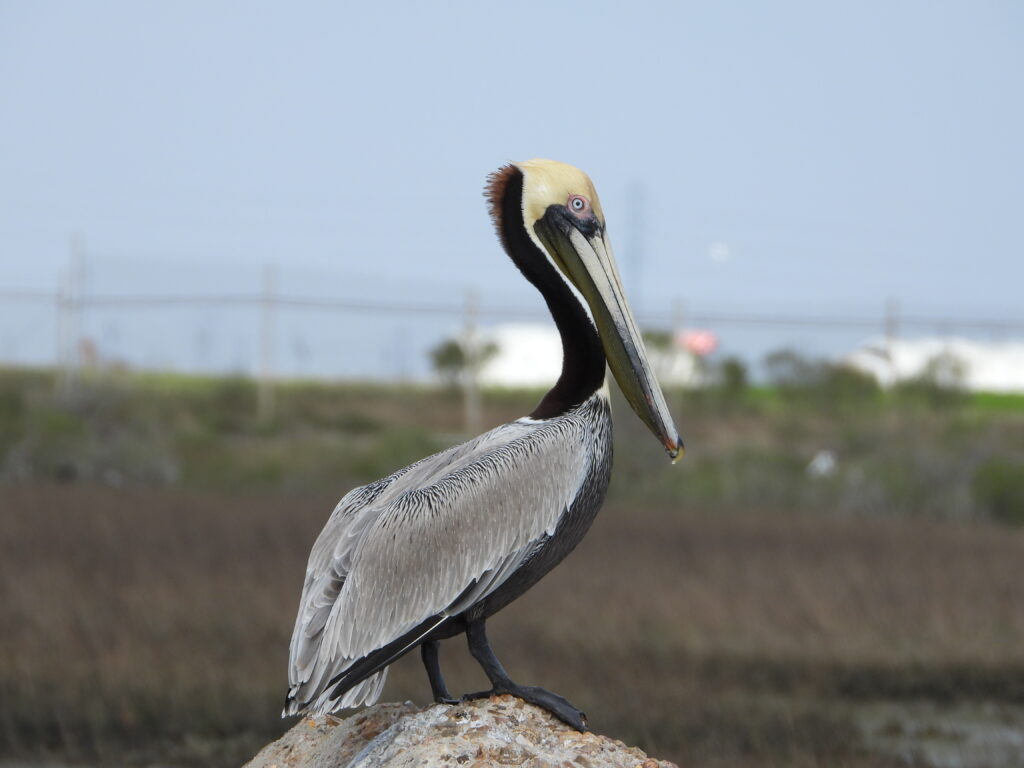By Kayla Pringle
The wind is in your hair, you can smell the salt in the air, and suddenly you see some huge birds flying in a formation. No other thoughts come to your head except “pelican!” Brown Pelicans, once a rare sight here, are now hard to miss as they glide over out Texas beaches. Their conservation story is unique and heartening, as they have recovered from sharp decline in the 1950s and 1960s.
In 1920, there were over 5,000 pairs of pelicans that nested on the Texas Coast. These birds are easy to identify and were a significant part of the ecosystem in this area. In the 1950s, observers started to notice that fewer and fewer adults were being counted and nesting was decreasing. Through surveys, they were able to conclude that no offspring fledged from 1964 to 1966. In 1969, an extensive survey counted only 116 brown pelicans along the entirety of the Texas coast, and none were spotted along the upper portion.

Additionally, in 1969, observers in California found broken eggs all over the ground where these pelicans were nesting. Their eggshells were so thin, that when they sat on them to keep them warm, they broke. This was certainly odd and concerning, but the exact cause was unknown.
In 1962, Rachel Carson wrote Silent Spring, a groundbreaking work that exposed the environmental and health dangers of indiscriminate pesticide use, particularly DDT. This pesticide, like many other chlorinated-hydrocarbon pesticides, build up in the environment as well as the birds’ food chains. Microorganisms soak up the chemicals washed onto the shore, the fish eat the microorganisms, and the pelicans eat the fish.
Most of the time, there wasn’t enough chemical buildup in the fish to fat out kill a bird, but it definitely affected their fertility and the integrity of the egg shells they produced. The use of DDT was also the main reason we saw declines in bald eagles, ospreys, and peregrine falcons.
Thanks to Rachel Carson and other conservationists, the use of DDT was banned in the United States in 1972. Afterwards, we have seen significant comebacks in all species mentioned and their population levels are on the rise.
Thankfully, the brown pelican has returned to the upper Texas coast. You can frequently see these birds diving for fish from heights as high as 60 feet. They fold their wings and dive head first, twisting during the dive to enter the water at a steep angle, nearly on their backs. They scoop up fish with their expanded pouches and resurface so they can drain all the excess water and swallow their catch. You can also see pelicans on boats, piers, and boardwalks, usually begging for a handout.
The brown pelican is a great example of a conservation success story. These birds, along with many other species, were near critical population levels, and now they are all listed as species of “Least Concern” according to the IUCN Redlist. The brown pelican’s recovery is a reminder that with sustained effort, policy reform, and public support, it is possible to reverse the damages we have caused to our natural world and the organisms it supports.
Photo by Celeste Silling. Caption: A Brown Pelican roosting on a rock.

